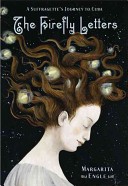
The Firefly Letters
Written By Margarita Engle
Henry Holt, 2010, 151 pp.
ISBN: 978-0805090826
Fredrika Bremer, who lived in the first half of the 19th century, was one of the earliest advocates of women’s rights. A friend of Hans Christian Andersen and other writers of that time, she was Sweden’s first woman novelist and her writings were the impetus for tens of thousands of Swedish immigrants to Cuba. Her rich sensory descriptions from a three-month visit to this country in 1851 are the substance of Margarita Engle’s poetic prose in this historical fiction.
In keeping with the style of her previous stories of Cuba’s struggles for freedom, Engle assumes the perspective of this historical author as she creates a sharp contrast between the beauty that Fredrika finds in Cuba and the painful instances of slavery she witnesses as slaves, many of them children, are brought illegally from Africa. Arriving in Cuba to quietly experience the serene beauty of this anticipated “Eden,” Fredrika sets out to discover how the people live with the help of her translator, a slave girl named Cecilia. Of special interest to her is the role and treatment of women and she fast becomes friends with Cecilia as well as Elena, the daughter of the plantation owner who is her host.
The story is told from the alternating voices of the characters, Fredrika, Cecilia, Cecilia’s husband, Beni, and Elena. Readers learn from Cecilia about being sold at age eight and brought to Cuba from Africa as a slave. Engle shares in her eloquent text the images of Africa that dwell in the mind of lonely Cecilia. Readers learn of Fredrika’s disdain of the wealthy life style of her parents and her decision to forego that wealth in order to travel, write and advocate for the rights of females. Elena reveals that she is jealous of this Swedish visitor who can roam as she desires around the countryside, talking to whom she wishes, unlike women and girls of her status in Cuba. Readers hear little from Beni but know his marriage to Cecilia was arranged and that he is a respectable slave.
As the three women reveal their thoughts, the narrative reflects the experiences of each during Fredrika’s visit. The social and political contexts of Cuba in 1851 are incorporated with an emphasis on how slavery was enacted in this island country. Fredrika records all in her journal—fireflies, slave dances, and stories of both Cuba and Africa. Engle uses subtle but powerful contrasts to point to the inequity of this era. Each image of the island’s natural beauty is contrasted with an image of slavery. The lonely and limited existence of the wealthy female is contrasted with the abuse shown towards more impoverished females, as women of both social classes desire freedom.
Award winning author Margarita Engle has already revealed through her earlier novels her personal interest and detailed research into the individuals who make up the history of Cuba. She includes both a historical note and an author’s note with a list of references for her work, the majority of which are the actual writings of Fredrika Bremer. In keeping with this theme of Cuban freedom, The Firefly Letters might be used with Engle’s other books, The Poet Slave of Cuba: A Biography of Juan Francisco Manzano (2006) and The Surrender Tree: Poems for Cuba’s Struggle for Freedom (2008) both reviewed in earlier issues of WOW Review. The struggle for women’s rights has been the focus of numerous children’s and young adult books, and this theme might be continued with such titles as Almost Astronauts: 13 Women Who Dared to Dream (Tanya Lee Stone, 2009) or Claudette Colvin: Twice toward Justice (Phillip M. Hoose, 2009).
Janelle B. Mathis, University of North Texas, Denton, TX
WOW Review, Volume III, Issue 1 by Worlds of Words is licensed under a Creative Commons Attribution-NonCommercial-ShareAlike 4.0 International License. Based on work at https://wowlit.org/on-line-publications/review/iii-1/

This book sounds like I would enjoy it. When I first started reading about it, I thought it was going to remind me of KIRA-KIRA. That book also mixes her native language into the text, but it flows enough that you can too usually figure out what it means through context. For this book, I would like the “aha” chapter titles and the complexity of the circle element. It’s also a good book to add to any collection as it’s always nice to be culturally diverse with your collection.